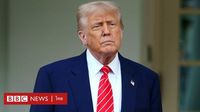In a significant development on the global economic front, the United States and Ukraine have recently entered into a critical mineral agreement that has drawn considerable attention. This deal, termed the "Critical Minerals and Rare Earths" agreement by U.S. President Donald Trump, aims to establish a joint investment fund to aid in the recovery of Ukraine. The agreement signifies a strategic pivot towards enhancing energy resources and mineral development in Ukraine, which has been under scrutiny due to ongoing geopolitical tensions.
According to Investing.com, the agreement was announced on May 10, 2025, and it emphasizes the importance of critical minerals in future-oriented industries. Trump remarked that these minerals are vital for the industrial development of Ukraine, which has been hampered by the ongoing conflict with Russia. The deal stipulates that the U.S. will support the development of Ukraine's untapped energy and mineral resources, with half of the revenue generated being funneled into a recovery fund for the country.
Despite the optimistic tone of the agreement, analysts have raised concerns regarding the feasibility and actual value of Ukraine's mineral resources. Capital Economics reported that Ukraine is believed to possess approximately 5% of the world’s mineral resources, including essential materials like lithium, titanium, and rare earths. However, there are significant doubts about the accuracy of these figures, as they are based on outdated Soviet-era geological data. The U.S. Geological Survey and other energy institutions have yet to confirm the presence of these critical minerals in Ukraine.
Furthermore, the economic viability of extracting these minerals remains questionable. The annual export revenue from Ukraine's critical minerals, including gallium, graphite, and titanium, is currently below $200 million, raising doubts about the profitability of expanding production. One notable site, Novopoltavske, has not been utilized for rare earth and phosphate extraction in over fifty years due to high extraction costs. As Capital Economics noted, "Access to technology and investment from Russia makes it easier to use projects from larger banks. If the industrial structure for future development is not understood, rare earth materials that are being promoted will still be in the area."
Adding to the complexity of the situation is the fact that around 40% of Ukraine's known mineral resources are located in territories currently controlled by Russia. This includes valuable resources that are part of the agreement, but access to them hinges on broader peace negotiations. Russian President Vladimir Putin has indicated a willingness to discuss access to these mineral sources, which could form part of a separate agreement.
The strategic implications of this agreement are profound, as it enhances U.S. economic interests in Ukraine amid a shifting global supply chain driven by geopolitical competition. According to Capital Economics, "Protecting material access will be important for Russia and its allies while the global industrial sector is still fragmented." The agreement also underscores Washington's efforts to reduce dependence on China for critical materials, a move that aligns with broader U.S. economic strategies.
While the agreement strengthens U.S. ties with Ukraine, it does not appear to significantly alter Russia's negotiating position or bring the ongoing conflict closer to resolution. Analysts caution that the complexities of the situation may hinder immediate benefits from the deal.
In a related context, the U.S.-China trade war has also seen recent developments. On the same day as the Ukraine agreement, senior officials from the U.S. and China met in Switzerland, marking the first high-level talks since Trump imposed tariffs on Chinese goods in January. This meeting comes amid escalating tensions, with tariffs on some Chinese imports reaching as high as 245%.
Stephen Olson, a senior researcher at the ISEAS-Yusof Ishak Institute in Singapore, noted the delicate balance both nations are trying to maintain: "Neither side wants to appear as if they are retreating." As the talks unfolded, both countries signaled a willingness to negotiate, although it remains unclear who would take the first step in de-escalating tensions.
Trump has claimed that the tariffs are strengthening the U.S. economy, while Chinese officials have expressed their commitment to fighting back against U.S. pressures. However, data indicates that the tariffs are adversely affecting both economies. In April, China's manufacturing activity fell to its lowest level since December 2023, and a recent survey revealed a decline in service sector activity to a seven-month low.
Despite the ongoing trade war, experts suggest that both nations recognize the necessity of reaching an agreement. Bert Hofmann, a professor at the National University of Singapore, remarked, "I think [China] realizes that reaching an agreement is better than having no deal at all. So they are taking a pragmatic view and saying, 'Okay, we need to start negotiating.'" As the discussions progress, the focus will likely be on foundational issues, with the possibility of setting an agenda for future talks.
Overall, these recent developments in both the U.S.-Ukraine mineral agreement and the U.S.-China trade negotiations illustrate the intricate and often precarious balance of global economic relations. As nations navigate these challenges, the outcomes will have far-reaching implications for international trade, resource management, and geopolitical stability.

